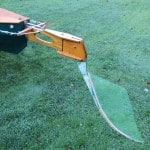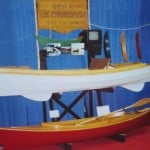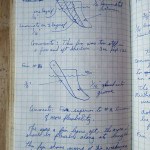* * *
OffCenterHarbor.com is a membership website with over 1,000 videos and articles
on boat handling, repairs, maintenance, boat building, dream boats and more.
Sign up above to learn more, and get 10 of our best videos.
* * *
Email This Page to a FriendPreview: Harry Bryan’s THISTLE, A Pedal-Powered Fin Boat
November 11, 2015
Ever wish you could swim through the water with a fish’s power and quiet gracefulness? Harry Bryan’s THISTLE, a pedal-powered Fin Boat, get’s you about halfway there.






Get Free Videos Start Free Trial Members Sign In
Transcript
– This concept began to interest me when we were on a cruise to Australia. We had used a pedal-powered floating beer coolers with the little thrashing wheel that my wife’s cousin had in North Carolina and found two things about it. One was it was a great deal of fun in the dismal swamp going around the trees and stuff and the other thing was it was horribly inefficient. In all that time I had crossing the Pacific I spent ages and ages thinking, catching fish, studying the way they propel themselves. Going to aquariums and watching fish through the glass walls and stuff. Originally I had gone for like a whale’s tale with two of these it would have been horizontal that was the concept that was, but that ran into the problem of needing to immerse it enough so that on the upstroke you didn’t break clear of the water and the mechanism itself would have to be underwater. Finally turned the idea of just using one fin and having that down, which also gives me steering, which the horizontal fin would not. It would had to have a separate rudder to do it. This is the fin drive mechanism from the pedal-powered fin boat. This pin goes through gudgeons on the stern of the boat as a pivot point and at the back end is the Lexan pin made of three pieces. A body of 1/16 and two layers of 3/16 to form the forward edge of the rib. This is what we came up with as the closest thing we could easily put together to mimic the action of a fish’s tail. I always use my hand to sort of demonstrate what I call pivoting here at the elbow joint and we have a wrist joint here and think of swimming with fish fins as well as how it propels. So here’s our elbow joint here and here’s our wrist joint here and much as you have muscles in your ankles for swimming with fins, this spring here adds to that. Without this spring to pedal at very low speed, you’d have very little propulsion because it would just swing but this adds some low speed propulsion to it. It locks up at a certain level by coming against this shock absorber, piece of foam inside some nylon webbing, And the angle that locks up in is almost exactly the same as the angle of the bones of a fish’s tail lock up at the furthest that it can bend before the actual caudal fin starts to propel it. This, when it swims over a rope, can kick up go back down again. If you run it in shallow water, no problem. Usually I’ll let it stick up like this and then give the boat a push. It has a paddle you can swing out into deeper water and give it a bit of a shake and that falls back down again and then you can propel the boat that way. Some people ask why don’t you just put this on the stern of the boat but this whole distance here gives a hugely greater swept area otherwise you’d have to take very tiny little pedal strokes to go anywhere. It’s steered by just holding it to one side and steering around a corner this way or the other side, just favoring one foot or the other. Very intuitive drive. Seems everybody gets it right away. This fin is put together with copper rivets and you see a slight stress crack there which will eventually grow out and cause a failure in this fin here. They’re very slow growing and from an engineering standpoint this pinpoint loading is a terribly poor way to do it. And some sort of bonding agent some polyurethane, methacrylate, something that works with Lexan should work. But I have not found one yet that didn’t change the properties of the Lexan. It either didn’t hold or caused it to be brittle. And by rounding those edges and keeping down a hard corner that can start a crack then I’ve gotten years out of one of these fins now where I used to get only a very short time out of them.
– Papa.
– Hello.

or …
